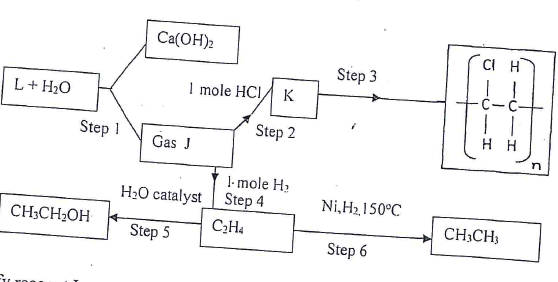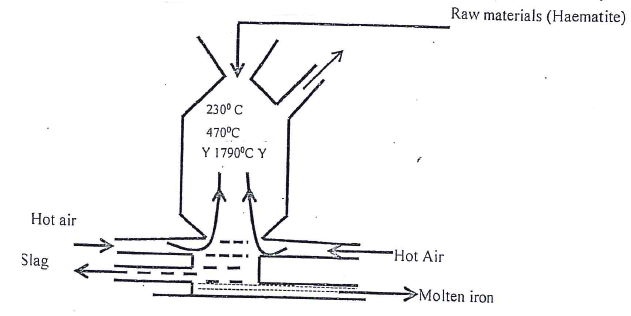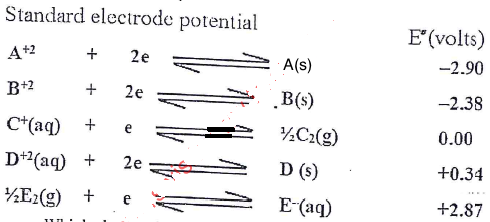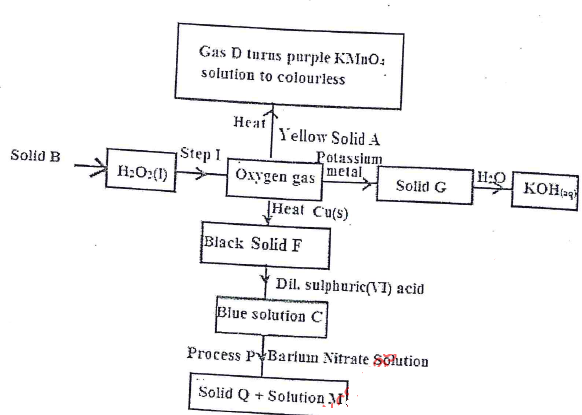Click the link below to download as a full set with all the subjects. (PDF)
https://downloads.easyelimu.com/details/35-Alliance_High_School_Pre_Trial_Examination
233/2
CHEMISTRY
PAPER 2
PRE-TRIAL EXAM MAY 2018
ALLIANCE HIGH SCHOOL
INSTRUCTIONS TO CANDIDATES
- Answer all the questions in the spaces provided
- Mathematical table and silent calculators may be used
- All the working must be clearly shown where necessary
- This paper consists of 8 questions
-
- Study the flow chart below and answer the questions that follow.

- Identify reagent L. (1 mk)
- Name the catalyst used in step 5. (1 mk)
- Draw the structural formula of gas J. (1 mk)
- What name is given to the process that takes place in step 5? (1 mk)
- Write the equation for the reaction between acqueos sodium hydroxide and aqueous ethanoic acid. (1 mk)
- Explain why the reaction between 1g of sodium carbonate and 2M hydrochloric acid is faster than the reaction between 1g sodium carbonate and 2M ethanoic acid. (2 mks)
- Study the flow chart below and answer the questions that follow.
- The grid below represents a section of the periodic table. Study it and answer the questions that follow:

- Give the formula of the compound formed between C and M. (1 mk)
- Which element forms a stable trivalent cation. (1 mk)
- Identify the least reactive element and give a reason for your answer. (2 mks)
- Explain how the melting point of J and K compare. (1 mk)
- Explain the differences in atomic and ionic radius of K. (1 mk)
- Write the electron arrangement of the following ions. (2 mks)
- K-
- C2+
- Element B is a soft substance and can easily be cut with a knife while element E is very hard. Explain. (1 mk)
- Iron is obtained from Haematite using a blast furnace show below. Study it and answer the questions that follow.

- Four raw materials are required for the production of iron. Three of these are haematite, hot air and coke. Give the name of the fourth raw material and its uses. (1 mk)
- Name another Iron ore other than the one shown in the blast furnace. (1 mk)
- State one physical property of slag other than density that allows it to be separaterd from molten iron as shown in the figure. (1 mk)
- Iron from the blast furnace contains about 5% carbon.
- Describe how the carbon content is reduced. (1 mk)
- Why is it necessary to reduce the carbon content? (1 mk)
- Explain why temperature in the region marked Y is higher than that of the incoming hot air (1 mk)
- Describe thr process which led to the formation of iron in the blast furnace. (3 mks)
- Give a reason why the melting point of the iron obtained from the blast furnace is 1200oC while that of pure iron is 1535oC (1 mk)
- One of the components of the waste gases is Nitrogen (IV) oxide. Describe the adverse effects it has on the environment. (3 mks)
-
- Define the term standard heat of formation of a substance. (1 mk)
- Butane cannot be prepared directly from it's elements and so it's standard heat of formation (ΔHof) must be obtained indirectly.
Write down an equation;- For the formation of butane from it's elements in their normal physical state at standard condition of temperature and pressure. (1 mk)
- For the combustion of 1 mole of butane. (1 mk)
-
- State the Hess's law. (1 mk)
- If the following heats of combustion are given,
ΔHco carbon(s) = -393 Kj/Mol
ΔHco H2(g) = -286Kj.Mol
ΔHco C4H10 = -2877Kj/Mol- Draw an energy cycle diagram linking the heat of formation of butane with its heat of combustion and the heat of combustion of constituent elements. (3 mks)
- Calculate the heat of formation of butane ΔHof
-
- Study the flow chart below and answer the questions that follow.

- Identify the metail ion present in solution M. (1 mk)
- Which property of the white precipitate Q is illustrated by steps I and II. (1 mk)
- Write the ionic equation for the reaction in step I that resulted in the formation of the colourless solution R. (1 mk)
- Study the reaction scheme below and answer the questions that follows.

- Name the reagents used in steps 2 and 3. (2 mks)
- Give one use of calcium sulphate. (1 mk)
- Water containing calcium hydrogen carbonate has temporary hardness. Write a chemical equation on how this water can be made soft using calcium hydroxide. (1 mk)
- Study the flow chart below and answer the questions that follow.
- Excess zinc granules was added to a beaker containing 100cm3 of dilute sulphuric (VI) acid. The beaker was then placed on a balance and the total loss in mass recorded after every two minutes as shown in the table below.
Time(minutes) 0 2 4 6 8 10 12 14 15 Total loss in mass(g) 0 7.0 9.6 11.5 13.0 13.7 14.0 14.0 14.0 - Why was there loss in mass? (1 mk)
- Calculate the average rate of loss in mass between
- 0 and 2 minutes. (1 mk)
- 4 and 6 minutes. (1 mk)
- Explain the difference in the average rates in b(i) and b(ii) above. (2 mk)
- Write a balanced equation for the reaction rate above could be increased. (3 mks)
-
- Plot the graph of total loss in mass(g) versus time (minutes) (3 mks)
- Use the graph to calculate the rate of the reaction when t = 5 minutes. (2 mks)
- Use the standard electrode potentials for element A, B, C and D given below to answer the questions that follow. The letters do not represent the actual symbols of the elements.

-
- Which element is likely to be hydrogen? Give a reason for your answers. (2 mks)
- What is Eo value of the strongest reducing agent? (1 mk)
- In the space provided, draw a labelled diagram of the electrochemical that would be obtained when half-cell of element B and D are combined. (3 mks)
- Calculate the Eo of the electrochemical cell contructed in (iii) above. (1 mk)
- During the electrolysis of aqueous copper (II) sulphate using copper electrodes, current of 0.2 A was passed through the cell for 5 hours.
- Write an ionic equation for the reaction that took place at the anode. (1 mk)
- Determine the in mass of the anode which occured as a result of the electrolysis. (3 mks)
-
- The flow chart below represents preparation of oxygen gs. Study it and answer the questions that follow.

- Identify the following substances. (2 mks)
- Solid A
- Gas D
- Solid Q
- Solution M
- Write a chemical equation for the:
- Formation of solid G. (1 mk)
- Gas D (1 mk)
- Blue solution (1 mk)
- In step I. (1 mk)
- State the confirmatory that for oxygen gas. (1 mk)
- Write the ionic equation for the reaction taking place in process P. (1 mk)
- State three uses of oxygen. (3 mks)
- Identify the following substances. (2 mks)
Download Chemistry Paper 2 - Alliance High School Pre-Trial Examination 2018.
Tap Here to Download for 50/-
Get on WhatsApp for 50/-
Why download?
- ✔ To read offline at any time.
- ✔ To Print at your convenience
- ✔ Share Easily with Friends / Students

